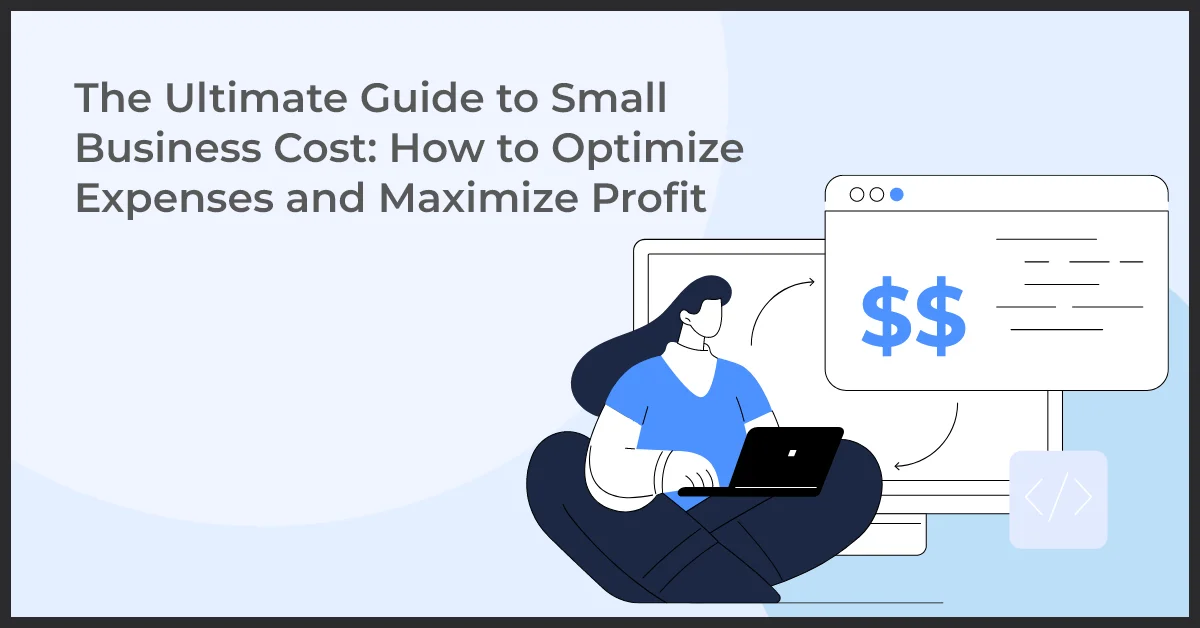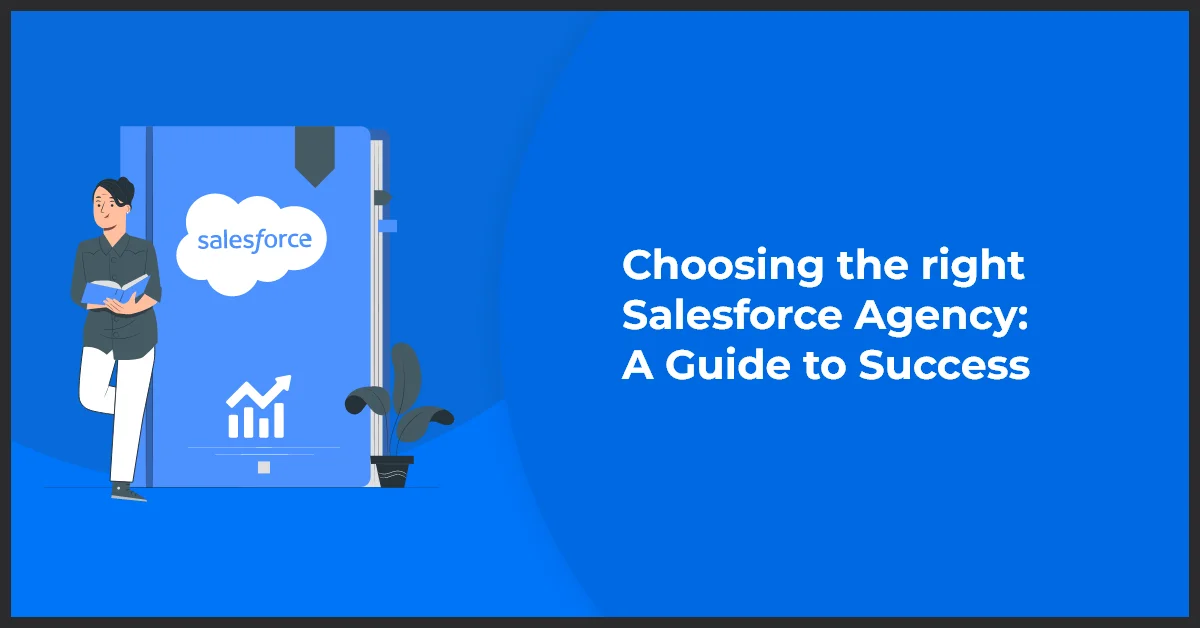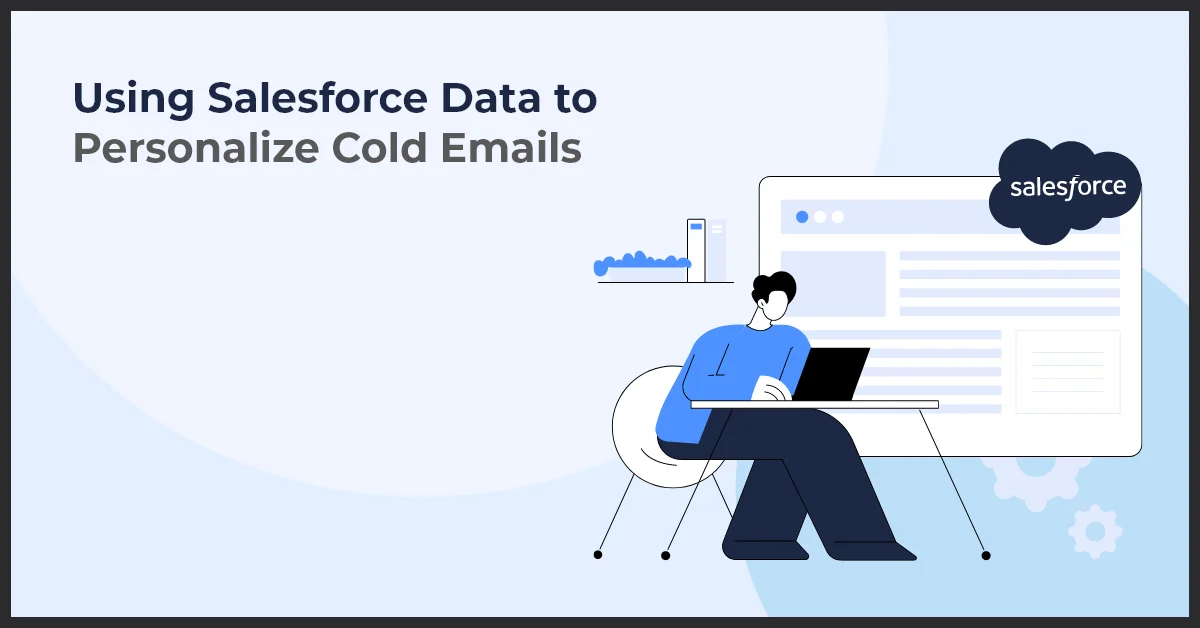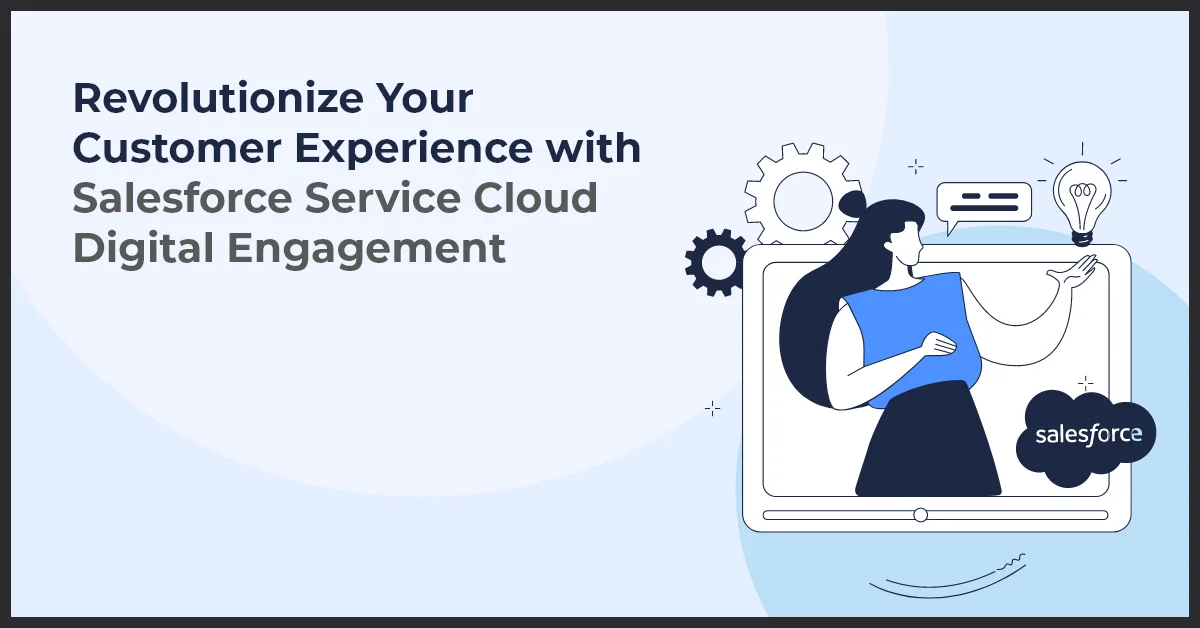How to Optimize Small Business Costs for Maximum Profit: A Complete Guide

Published on: November 6, 2023
Updated on: March 11, 2025
2886 Views
- Salesforce
21 min read
Generally, a small business is a privately owned company with fewer employees and lower revenue than a larger corporation. However, the significance of understanding small business costs goes far beyond simple categorization.
When starting and running a small business, one of the critical factors for success is managing costs effectively. Every decision, from purchasing equipment to hiring employees, has a direct impact on the financial health and sustainability of a small business. By understanding the intricacies of small business costs and implementing cost-saving strategies, entrepreneurs can optimize expenses and maximize profits.
Overview of Small Business Costs
Running a small business can be an exciting and rewarding venture. However, it is essential to understand the various costs and expenses that come along with it. By having a comprehensive overview of small business costs, you can better manage and control your expenses, ultimately increasing profitability.
Definition of Costs and Expenses
Costs and expenses refer to the financial outlays a small business incurs to operate and maintain its daily operations. These can be categorized into various types, each contributing to the overall financial health of your business.
Importance of Managing and Controlling Costs
Managing and controlling costs is crucial for the long-term success of your small business. By effectively monitoring and minimizing your expenses, you can ensure that your business remains profitable. With proper cost management, your business may avoid financial challenges and struggle to stay afloat.
Impact of Costs on Small Business Profitability
The costs associated with running your small business directly impact its overall profitability. High costs can eat into your revenue and reduce your profit margins. On the other hand, effectively managing your costs can increase your profit and pave the way for growth and expansion.
Factors Influencing Small Business Costs
Several factors influence the costs incurred by small businesses. These factors include the size of your business, the industry you operate in, your geographical location, and the nature of your products or services. It is essential to analyze these factors to understand how they directly or indirectly affect your costs.
Start-up Costs
Meaning and significance of start-up costs
Start-up costs refer to the expenses incurred by a small business when it is initially setting up or starting its operations. These costs are essential for getting the business off the ground and vary depending on the type and size of the business.
Breakdown of typical start-up expenses:
- Licensing and permits: This includes fees associated with obtaining the necessary licenses and permits required to operate the business.
- Equipment purchases: These costs cover acquiring machinery, tools, computers, or any other equipment essential for the business's operations.
- Initial inventory: Every business needs an initial stock of products or supplies to start selling. The cost of purchasing the initial inventory is included in start-up expenses.
- Marketing expenses: Allocating a budget for marketing and advertising activities is crucial to create awareness and attract customers. These costs cover digital marketing, website development, and advertising campaigns.
- Professional fees: These expenses are associated with hiring lawyers, accountants, consultants, or other professional services required during the start-up phase.
- Lease or rent deposits: If the business requires physical space, the start-up costs may include the deposits or upfront payments associated with leasing or renting the premises.
Strategies to reduce start-up costs
Minimizing start-up costs is paramount for small businesses seeking to maximize their resources. Here are a few practical strategies:
- Bootstrapping: Utilizing personal savings or relying on funds from friends and family to finance the business.
- Bartering: Trading goods or services with other businesses instead of paying cash.
- Seeking grants and incentives: Exploring governmental or nonprofit initiatives that financially support small businesses.
- Leasing instead of buying: Opting to lease equipment or space instead of purchasing outright to reduce upfront costs.
Operating Expenses
Operating expenses are the ongoing costs that small businesses incur to keep their operations running smoothly. These expenses are essential for day-to-day business activities and vary depending on the nature of the business. By understanding and effectively managing these expenses, small business owners can ensure their financial stability and growth.
Definition and Examples of Operating Expenses
Operating expenses, also known as operational costs, are the expenses incurred in the regular course of business operations. These expenses are necessary for the production, sales, and delivery of goods or services. Examples of operating expenses include:
- Rent or mortgage payments
- Utilities
- Insurance
- Payroll and employee benefits
- Inventory replenishment
- Marketing and advertising expenditures
These costs can significantly impact a small business's profitability, so it's crucial to manage them to maintain financial health effectively.
Analysis of Common Ongoing Costs for Small Businesses
Let's dive deeper into some common operating expenses that small businesses typically encounter:
- Rent or Mortgage Payments: This expense includes leasing a commercial space for operations or mortgage payments for a business property.
- Utilities: These include electricity, water, gas, internet, and other utility bills necessary to run the business.
- Insurance: Businesses often need insurance coverage for various aspects, such as liability insurance, property insurance, and worker's compensation insurance.
- Payroll and Employee Benefits: This comprises wages, salaries, taxes, and employee benefits.
- Inventory Replenishment: The ongoing costs associated with restocking inventory and supplies needed for production or sale.
- Marketing and Advertising Expenditures: Costs incurred in promoting the business, such as advertising campaigns, online marketing, and promotional materials.
Understanding and managing these expenses can help small business owners optimize their operations and improve profitability.
Legal and Regulatory Costs
As a small business owner, it is crucial to understand and budget for the various legal and regulatory costs involved in running your business. These expenses are necessary to ensure compliance with laws and regulations, protect your intellectual property, and mitigate risks.
Importance of legal and regulatory compliance
Complying with legal and regulatory requirements is essential for the long-term success of your small business. Failure to do so can result in fines, penalties, legal disputes, or even business closure. By prioritizing compliance, you demonstrate your commitment to ethical business practices and gain the trust of customers, investors, and partners.
Overview of legal and regulatory cost components
- Business licenses, permits, and certifications: Obtaining the necessary licenses, permits, and certifications can be a significant upfront cost for small businesses. These requirements vary depending on your industry and location. It is essential to research and understand the specific licenses and permits required for your business operations.
- Tax law compliance: Understanding and complying with tax laws is crucial to avoid penalties or audits. Small businesses need to accurately calculate and pay various taxes, such as income tax, sales tax, and payroll taxes. Seeking professional assistance or using accounting software can simplify this process.
- Intellectual property protection: Protecting your intellectual property, such as trademarks, copyrights, and patents, is vital for securing your unique assets and preventing others from misusing or stealing your ideas. Registering and maintaining these protections may incur costs but are essential for safeguarding your business.
- Legal counsel fees: Sometimes, it may be necessary to seek legal advice or representation for issues such as contract negotiations, disputes, or compliance matters. Hiring an attorney can be costly, but their expertise can help you navigate complex legal situations and avoid potential pitfalls.
Risk mitigation strategies to control legal and regulatory costs
To minimize legal and regulatory costs, small businesses can implement the following risk mitigation strategies:
- Stay updated on changes in laws and regulations relevant to your industry.
- Establish internal processes and controls to ensure compliance.
- Seek cost-effective legal advice or consider legal retainer services.
- Keep detailed records and documentation to demonstrate compliance.
- Invest in employee training to ensure awareness of legal and regulatory requirements.
Employee Expenses
A significant aspect of running a small business is managing employee expenses. These costs play a crucial role in the overall financial health of a small business and require careful consideration. By understanding and optimizing employee-related expenses, small businesses can effectively allocate their resources.
Breakdown of Employee-related Costs
- Wages, Salaries, and Payroll Taxes: One of the main components of employee expenses is the payment of wages and salaries. Additionally, small businesses are responsible for payroll taxes, which include Medicare, Social Security, and unemployment taxes.
- Employee Benefits: Providing benefits like health insurance and retirement plans is another essential factor to consider. These employee benefits not only contribute to attracting and retaining talent but also add to the overall employee expenses.
- Training and Development: Small businesses should allocate resources for training and development programs to enhance the skills and knowledge of their employees. This investment helps improve productivity and ensures business growth.
- Recruitment: Hiring new employees involves expenses such as advertising job postings, conducting interviews, and background checks. Allocating a budget for recruitment activities is vital for a small business to attract the right talent.
Strategies for Optimizing Employee-related Costs
While employee expenses are inevitable, there are strategies that small businesses can adopt to optimize such costs:
- Implementing Employee Performance Evaluations: Regular evaluations allow businesses to identify top-performing employees, recognize their contributions, and provide incentives accordingly. This approach helps streamline employee-related costs by rewarding high-performing individuals.
- Simplifying Processes and Automating Tasks: By utilizing technology and automation, small businesses can reduce manual labor and improve efficiency. This not only saves time but also minimizes operational costs related to employee tasks.
- Negotiating Benefits and Insurance Plans: Small businesses can explore dealing with insurance providers and benefit vendors to get the best rates. This can result in significant cost savings without compromising employee benefits.
Examples of Successful Employee Expense Management
Several successful small businesses have implemented effective strategies to manage employee expenses:
- Flexible Work Arrangements: By offering remote work options or flexible hours to employees, businesses can reduce expenses related to physical office spaces and utilities.
- Investing in Employee Training: Training existing employees rather than always hiring new ones can lead to cost savings in recruitment and onboarding.
- Outsourcing Non-core Functions: Instead of hiring full-time employees for non-core functions like accounting or IT support, small businesses can outsource these tasks to specialized service providers.
By effectively managing and optimizing employee expenses, small businesses can ensure their resources are utilized efficiently, contributing to their overall success.
Marketing and Advertising Costs
Marketing and advertising play crucial roles in the success of small businesses. These activities help attract new customers, increase brand awareness, and drive sales. However, they also come with their fair share of expenses. In this section, we will explore the various components that makeup marketing and advertising costs for small businesses.
Advertising campaigns
Running advertising campaigns is a common and effective way to reach a target audience. Whether through television, radio, or online platforms, advertising campaigns require financial investment. Costs can vary depending on the duration and reach of the campaign, as well as the chosen advertising medium.
Website design and maintenance
A well-designed and user-friendly website is essential for any small business. The costs associated with website design and maintenance include:
- Hiring professional web designers.
- Purchasing a domain name.
- Hosting fees.
- Regular updates and maintenance.
Social media marketing
Social media has become a powerful tool for businesses to engage with their audience and promote their products or services. Small businesses must allocate a portion of their budget for social media marketing strategies, including content creation, sponsored posts, and influencer collaborations.
Content creation
Creating high-quality content is a crucial aspect of marketing and advertising. Whether it's blog articles, videos, or infographics, small businesses need to invest in content creation to communicate with their target audience effectively. Costs may include hiring content writers, graphic designers, or video editors.
Online and print advertisements
Small businesses often utilize online and print advertisements to reach their target market. Online ads can include pay-per-click (PPC) campaigns, website banner ads, or sponsored content. Print advertisements, on the other hand, can involve costs such as graphic design, printing, and distribution.
Promotional materials
Investing in promotional materials, such as business cards, brochures, and merchandise, is another component of marketing and advertising costs. These materials help raise brand awareness and leave a lasting impression on potential customers.
While marketing and advertising costs can add up, there are approaches that small businesses can take to optimize their expenses:
Approaches for cost-effective marketing and advertising
- Focus on targeted marketing campaigns to reach a specific audience rather than casting a wide net.
- Utilize affordable online marketing channels, such as social media platforms, email marketing, and search engine optimization (SEO).
- Collaborate with local influencers or non-competitive businesses for joint marketing efforts.
- Monitor and analyze marketing metrics to optimize campaigns and allocate budget wisely.
Successful marketing cost optimization can be seen in various case studies:
Case studies exemplifying successful marketing cost optimization
- A small coffee shop increased customer visits by 30% by targeted Facebook ads, measuring campaign performance using conversion tracking.
- An online boutique utilized user-generated content on Instagram to establish social proof and boost sales, reducing the need for expensive influencer collaborations.
- A local bakery partnered with nearby businesses to cross-promote their products, reducing advertising costs while reaching a wider audience.
Marketing and advertising costs are necessary investments for small businesses to thrive in today's competitive landscape. By carefully planning and optimizing these expenses, small businesses can maximize their reach and achieve their marketing objectives.
Technology and Software Expenses
Technology is crucial in small businesses, enabling them to streamline operations, expand their reach, and improve efficiency. However, the cost of technology and software can significantly impact a small business's budget. In this section, we will explore the various elements that contribute to technology and software expenses.
Role of technology in small businesses
Technology empowers small businesses by providing them with tools and solutions that were previously exclusive to larger corporations. Small business owners can leverage technology to automate processes, analyze data, enhance communication, and establish an online presence.
Breakdown of technology and software cost elements
To better understand technology and software expenses, let's break down the different cost elements involved:
- Technology infrastructure: This includes the essential hardware, software, and network infrastructure required to support a small business's operations.
- Hardware: Computers, laptops, servers, printers, and other hardware devices are necessary investments for small businesses to carry out their daily tasks efficiently.
- Software licenses: Small businesses often rely on various software applications to manage their operations, such as accounting software, project management tools, or customer relationship management (CRM) systems. Acquiring licenses for these software solutions involves costs.
- Internet and telecommunications services: An internet connection and reliable telecommunications services are essential for small businesses to communicate with their customers, suppliers, and employees.
- Cybersecurity measures: Protecting sensitive data and digital assets from cyber threats is vital for small businesses. Investing in cybersecurity measures, such as firewalls and antivirus software, helps minimize the risk of data breaches.
- Website hosting: Establishing an online presence through a website requires web hosting services, which incur recurring expenses.
Strategies to minimize technology and software expenses
Small businesses can implement strategies to reduce technology and software expenses without sacrificing functionality or efficiency. Some effective strategies include:
- Researching and comparing software options to find affordable alternatives.
- Utilizing cloud-based solutions that offer cost-effective scalability.
- Considering open-source software options that provide robust features without expensive licenses.
- Implementing energy-efficient hardware to reduce power consumption and operational costs.
- Negotiating with vendors for discounted pricing or flexible payment plans.
Real-world examples of successful technology expense management
Several small businesses have effectively managed their technology expenses by implementing innovative cost-saving strategies. By leveraging open-source software, transitioning to cloud-based solutions, and adopting a proactive approach to cybersecurity, these businesses have reduced their overall technology and software costs while maintaining operational excellence.
Inventory and Supply Chain Costs
Efficient inventory and supply chain management is crucial for small businesses as it directly impacts their overall cost structure. By effectively managing inventory and supply chain costs, small businesses can improve their profitability and competitiveness in the market.
Significance of efficient inventory and supply chain management
Efficient inventory and supply chain management enable small businesses to minimize the costs associated with holding excess inventory and streamline their overall operations. By optimizing inventory levels, businesses can avoid stockouts and reduce the need for costly rush orders.
Detailed examination of inventory and supply chain cost components
- Raw materials: The cost of raw materials directly impacts a small business's inventory and supply chain costs. By negotiating favorable pricing with suppliers, businesses can reduce their raw material expenses and enhance their bottom line.
- Finished goods: As small businesses produce and sell finished goods, the cost of inventorying these products needs to be considered. Efficient inventory management practices can minimize the carrying costs associated with holding finished goods.
- Packaging materials: Packaging materials is an essential component of inventory and supply chain costs. Small businesses can explore cost-effective packaging options or seek bulk discounts to reduce this expense.
- Storage: Small businesses need to allocate resources for storing their inventory. Efficient utilization of storage space, such as implementing vertical storage systems, can optimize storage costs and improve overall efficiency.
- Distribution and shipping: Distributing and shipping products to customers is a significant part of the supply chain costs. Small businesses can explore different shipping options, negotiate rates with carriers, and implement efficient order fulfillment processes to minimize these costs.
- Logistics: Managing logistics efficiently is crucial for small businesses to control supply chain costs. By optimizing transportation routes, consolidating shipments, and using technology to track and manage inventory, businesses can minimize logistical expenses.
Financial and Administrative Costs
Managing the financial and administrative expenses of a small business is crucial for its overall success and sustainability. By carefully analyzing and minimizing these costs, small business owners can ensure that their operations remain efficient and profitable.
Analysis of Financial and Administrative Cost Elements
- Accounting and bookkeeping fees: Small businesses often require the assistance of accounting professionals to maintain accurate financial records, prepare tax filings, and analyze financial statements.
- Banking fees: Business owners must consider the fees associated with maintaining a business bank account, such as transaction fees, monthly maintenance fees, and wire transfer fees.
- Insurance premiums: Small businesses may need insurance coverage to protect against potential risks, such as liability insurance, property insurance, or workers' compensation insurance. The cost of insurance premiums can vary depending on the type and level of coverage required.
- Business loans or interest payments: If a small business requires financial assistance through loans or credit facilities, interest payments become a significant financial burden. Careful consideration should be given to the terms and conditions of the loans to manage costs effectively.
- Budgeting and forecasting tools: Small businesses may invest in budgeting and forecasting tools to effectively plan and manage their finances. While these tools may incur upfront costs, they can help streamline financial processes and improve decision-making.
Strategies for Minimizing Financial and Administrative Costs
Small business owners can adopt the following strategies to minimize financial and administrative costs:
- Outsourcing: Consider outsourcing specific administrative tasks, such as payroll processing or tax preparation, to reduce the need for dedicated in-house staff.
- Regularly review expenses: Continuously analyze expenses to identify areas where cost-saving measures can be implemented without sacrificing quality or efficiency.
- Negotiating with vendors: Negotiate favorable terms with vendors and suppliers to secure better pricing and payment arrangements.
- Embracing technology: Utilize software and digital tools to automate administrative processes, streamline workflow, and reduce manual errors.
- Evaluating insurance coverage: Regularly review insurance policies to ensure appropriate coverage levels and competitive premiums.
Maintenance and Repairs
Regular maintenance and repairs are essential for small businesses to ensure the smooth running of operations and avoid costly disruptions. Neglecting these tasks can lead to more significant issues in the long run, resulting in higher repair expenses and potential downtime. Here, we explore the significance of regular maintenance and repairs for small businesses and strategies to minimize associated costs.
Significance of regular maintenance and repairs for small businesses
Keeping up with maintenance and repairs is crucial for small businesses for several reasons. First and foremost, it helps maintain the functionality and efficiency of business premises, equipment, vehicles, and other assets. By addressing minor issues promptly, businesses can prevent them from escalating into major problems that could result in costly breakdowns or replacements.
Regular maintenance also extends the lifespan of assets, reducing the need for frequent replacements. This not only saves money and resources but also enhances the overall sustainability of the business. Moreover, businesses that prioritize maintenance and repairs demonstrate professionalism and a commitment to delivering quality products or services, which can enhance their reputation and customer satisfaction.
Breakdown of maintenance and repair cost components
When it comes to maintenance and repair expenses, small businesses need to consider various cost components. These can include:
- Business premises: Cost of maintaining the physical space, such as plumbing, electrical, and structural repairs.
- Equipment: Expenses related to servicing, repairing, or replacing machinery, tools, and other equipment used in daily operations.
- Vehicles: Costs associated with regular maintenance, repairs, and inspections of company vehicles.
- Other assets: Maintenance and repair expenses for computers, software, furniture, and fixtures.
Approaches to minimize maintenance and repair expenses
Small businesses can adopt various strategies to minimize maintenance and repair expenses:
- Regular inspections: Conducting routine inspections can help identify potential issues early on, allowing for timely repairs or preventive measures.
- Maintenance schedules: Creating and adhering to maintenance schedules ensures that assets receive the necessary care and attention regularly.
- Proactive repairs: Addressing minor issues promptly can prevent them from escalating into major problems, saving businesses from costly repairs or replacements.
- Training and education: Providing proper training to employees on equipment handling and maintenance can minimize the risk of damages and the need for frequent repairs.
- Vendor partnerships: Building relationships with reliable vendors can lead to cost-effective maintenance and repair services or discounts.
Case studies highlighting effective maintenance and repair cost control
Looking at successful case studies can provide valuable insights into effective maintenance and repair cost control strategies for small businesses. These real-life examples demonstrate how businesses have implemented measures to optimize their maintenance processes, reduce expenses, and improve overall operations.
Taxes and Fees
As a small business owner, it's crucial to understand the various tax and fee obligations that come with running a business. Failing to comply with these obligations can result in penalties and financial setbacks. In this section, we will delve into the different types of taxes and fees that small businesses typically encounter.
Understanding tax and fee obligations for small businesses
Regarding taxes and fees, small businesses must meet certain obligations to ensure compliance with the law. These obligations vary depending on the business structure, location, and annual revenue. Familiarizing yourself with these obligations is essential for smooth operations and avoiding any legal complications.
Analysis of various taxes and fees
Small businesses encounter a range of taxes and fees that need to be accounted for. Let's take a closer look at some of the most common ones:
- Income taxes: Small businesses are typically subject to federal, state, and sometimes local income taxes. Understanding the tax rates, deductions, and credits available to your business can help you accurately calculate and manage your tax liability.
- Sales taxes: If your small business sells products or services, you may need to collect and remit sales taxes to the relevant tax authorities. The rates and regulations for sales taxes vary from state to state, so it's essential to stay updated on your specific obligations.
- Property taxes: If your business owns real estate or personal property, you may be liable for property taxes. Local governments assess these taxes and can vary depending on the value and location of your assets.
- Business registration fees: When starting a small business, you may need to pay registration fees to establish your entity legally. These fees typically cover the administrative costs associated with processing the necessary paperwork.
- Local or state government fees: Depending on your industry and location, your business may be subject to additional fees imposed by local or state governments. These fees could be for permits, licenses, or specific industry-related regulations.
Conclusion
Small business owners need to have a clear understanding of these different cost categories and develop effective strategies to optimize and control them. By closely monitoring and managing these costs, small businesses can improve profitability and stay competitive in today's challenging business environment.
Therefore, we encourage small business owners to take proactive steps in managing their costs. By regularly reviewing and analyzing expenses, exploring cost-saving opportunities, and seeking professional advice, small business owners can effectively control their costs and maximize their chances of success.



